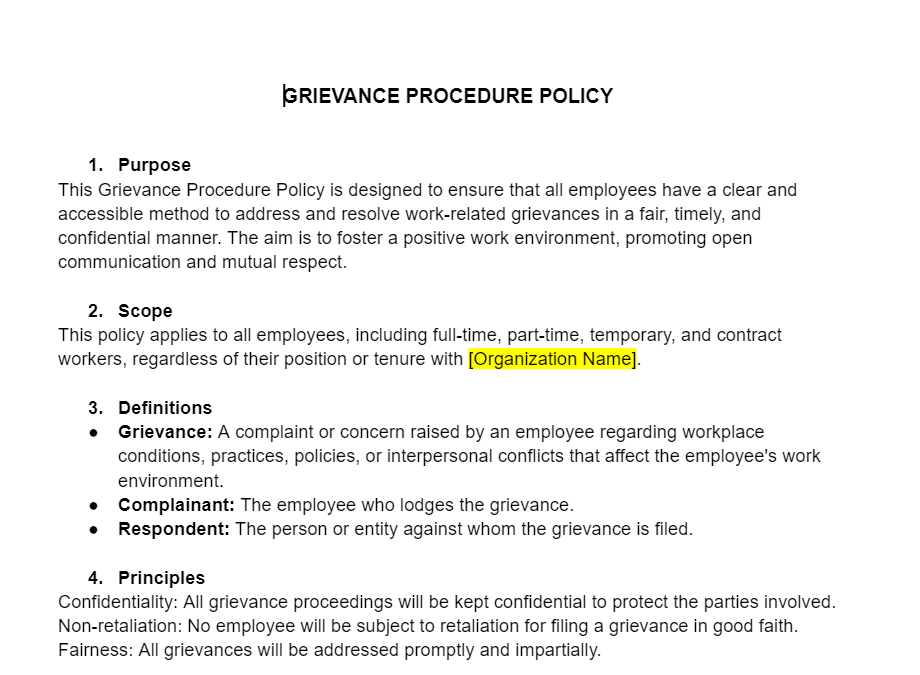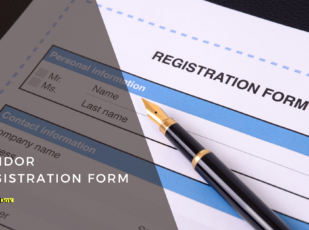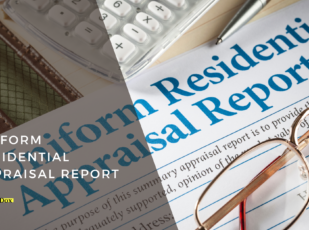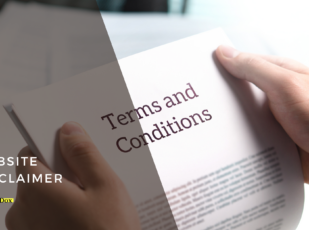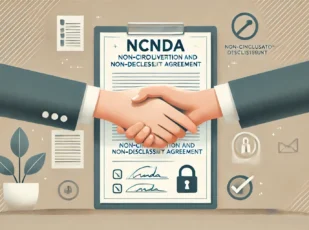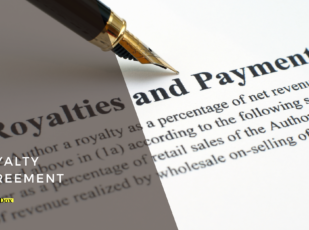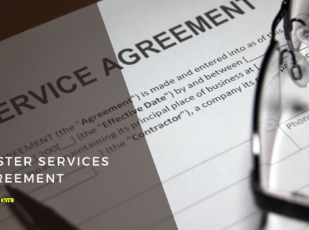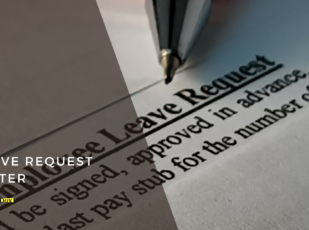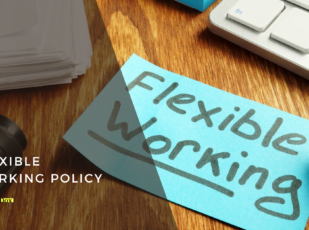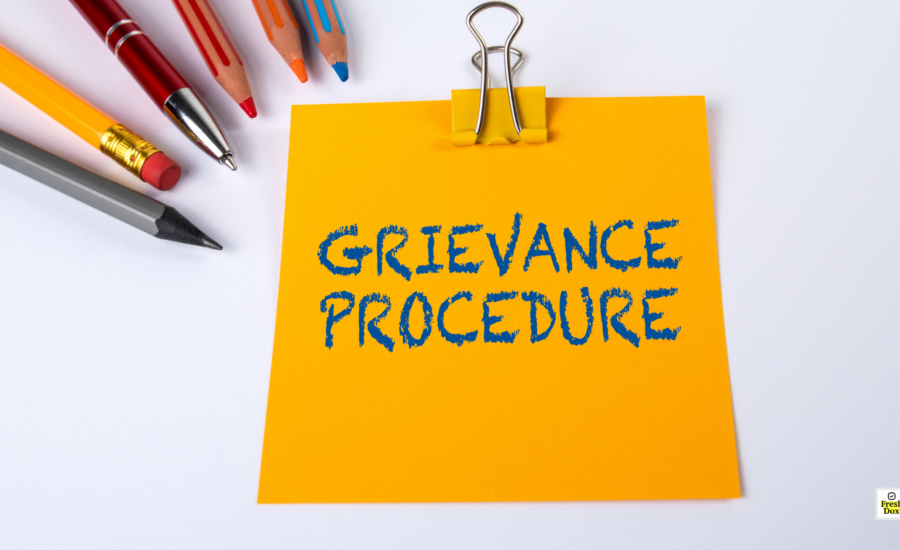
Grievance Procedure Template
7 Downloads
Corporate
January 2, 2025
Sayantani Dutta
Workplace harassment, bullying, and pay disputes lead to employees lodging formal grievances in around two-thirds of all American companies. Organizations need policies in place to deal with these issues. A comprehensive grievance procedure is a non-negotiable practice for companies operating in all levels of business, from the largest corporates to mom-and-pop retail stores.
This procedure addresses employee issues quickly and fairly. It sets the stage for an improved employee experience and a company culture founded on trust and transparency.
Let’s examine why your company needs a grievance procedure. We’ll also give you an option to download a grievance procedure template from our archive, and spoiler alert, you can get it free right now with a 7-day trial of the FreshDox platform.
Grievance Procedures Explained
Grievance procedures offer a way for employees to formally lodge complaints regarding workplace issues such as sexual harassment, unsafe working conditions, problems with management behavior, pay disputes, and other minor or major issues.
Companies that have a thorough grievance procedure in place set the stage for a productive workplace environment where employees get along with each other and management. It’s a feedback framework providing a conduit for employees to express their concerns in a formal setting, identifying issues within the company that require immediate resolution and change.
For employers and employees, a grievance indicates a problem in the company and if left unresolved, employees can use the documentation collected in the grievance procedure to pursue legal action against their employer.
The HR department plays a central role in initiating and managing the grievance procedure. The HR team is responsible for compiling the procedure, rolling it out in the company, assisting managers in their investigations, and supporting the employee during every step of the procedure.
After concluding the investigation, HR provides the findings of the investigation to the parties involved in the grievance, and management.
They also support those who are raising the grievance and the subjects of the grievance, and provide advice on the outcomes of the complaints. The HR team issues a copy of the grievance to the employee and files a copy in the company’s records.
The Types of Workplace Grievances
We can categorize employee grievances into four basic categories, depending on who initiates the grievance procedure.
Collective Group-Based Grievances
These are issues facing several employees who band together as a group to lodge a formal grievance. Unfair workplace practices, unsafe working conditions, and inadequate facilities are a few examples of issues where several employees experience the same problem, like unfair workload distribution, changes to shift structures, or issues with employee benefits.
Individual Personal Grievances
These are grievances initiated by a single employee. For instance, they might experience bullying by their immediate supervisor over their sexual orientation. The damaged relationship leads to unfair poor performance reviews by the line manager and the denial of a promotion, even though the employee is the best candidate for the position.
Grievances in Organizations
These grievances surround issues with the way companies apply or interpret policies, such as employee concerns surrounding unethical or illegal practices within the company. These grievances also include widespread issues within the company, such as pervasive management problems and systemic discrimination.
Grievances in Unions
These are grievances affecting workers involved in Union jobs, such as contract breaches, or violations of collective bargaining agreements with their employer or trade union representative.
This category also covers grievances relating to the treatment and recognition of the union by an employer.
Examples would be the company failing to consult the union representatives on issues surrounding the unfair dismissal of union employees or big workplace changes that should be brought to the attention of union members. Union grievances can also include labor disputes between management and union reps, such as negotiations regarding working conditions, wages, and terms of employment.
Outlining the Steps in the Formal Grievance Procedure
Informal employee complaints are usually the catalyst for lodging a formal grievance with HR and the initiation of the formal grievance procedure. While companies generally have a unique way of handling the procedure, there are general guidelines that most organizations and HR teams follow when rolling it out.
The following procedure is an example of common steps involved in lodging a formal grievance and what employees, employers, and HR can expect from each stage of the process.
Step 1: Filing a Written Formal Complaint
Formal grievance complaints are written documents. Human Resources issues the grievance form to the employee after they raise a verbal complaint, capturing the employee’s statement to start the beginning of the paper trail.
This document guides the grievance procedure and captures details like the date of the incident and the employees or managers involved. It’s important for the employee to be as detailed as possible when issuing their statement. While a formal interview is usually conducted by HR later in the process, their initial statement forms its foundation.
After filing the grievance form HR launches an official investigation into the matter. The type of grievance determines the extent of the investigation. For instance, a grievance about paycheck inaccuracies might be easy to resolve in a matter of minutes or hours with a simple call to the payroll department.
A more severe offense, such as a line manager sexually harassing a lower-level employee may require an extensive investigation lasting days or weeks. HR may need to collect evidence such as auditing email conversations and reviewing CCTV footage. Typically, both the complainant and the accused will need to sit through several interviews during the investigation.
Some in-depth investigations may require the HR team to bring in an expert, such as a polygraph specialist while other grievances may only involve the employee and an HR manager.
Step 2: Reporting the Findings of the Investigation
Some grievances may be cut-and-dry situations, requiring simple solutions. For instance, an investigation into a grievance involving incorrect overtime pay might unveil unprocessed or lost time cards to back up the employee’s claims.
In harassment or discrimination cases between coworkers, the solution might not be so easy to find. For instance, an employee might complain about their manager or coworkers using racial slurs against another employee. Upon investigating the issue it turns out that the complainant was also party to this behavior, causing an unexpected outcome for the employee filing the grievance.
Step 3: Mediation and Arbitration
This step in the grievance process is common in union complaints and disputes involving contractors. For instance, if there’s a harassment or discrimination case where tensions between the accusor and accused run high, a mediator and arbitrator provide an impartial perspective to the situation that’s free of bias.
The mediator and arbitrator work with both the company and the employee to reach an amicable solution that benefits both parties to the grievance. In the case of union contracts the union representative, and possibly their legal counsel, will represent the employee during the process.
Step 4: Consequences
If the mediation process leads to the formation of a formal agreement or the investigation results in a recommendation accepted by the company, the company may turn to its disciplinary procedure for guidance on any disciplinary action taken. Sometimes the action might be as simple as a suspension or warning, and in other cases, it might be as severe as terminating the offending party.
Step 5: The Right to Appeal
If the employee feels the outcome of the investigation and dispute resolution are not to their satisfaction, they have the right to appeal and take the company to court. In some instances, there may be a contract preventing a court case and mediation is the final outcome of the grievance procedure. How the employee can leverage the appeal process should be clearly outlined in the grievance policy.
Step 6: Follow Up
After settling the grievance, HR, the union rep, or the employee’s legal representative involved in the process must follow up with the employee to ensure everything is settled to their preferences.
What is the Timeline for the Grievance Procedure?
The nature of the grievance determines the timeline of the procedure. If there are several employees involved in the complaint or it’s an overly complicated situation for the investigation team to unpack, it could take weeks or even months for the HR team to resolve the issue.
Conversely, if it’s a one-off incident or a simple matter to resolve, HR could wind up the process in a matter of hours or days. The HR team should clearly outline the timeframe for each of the steps in the grievance process and make the complainant aware of the timeline of events to come.
Best Practices for Writing Formal Grievance Policies
Disclaimer: These practices are just guidelines and some HR departments and companies may take a modified approach to forming the employee grievance policy compared to what we’ll outline below.
That’s where the FreshDox Grievance Procedure Template comes into play. Companies can customize the document to the organization’s policies to include any information or steps they want in their internal grievance policy and procedures.
Definition
The opening section should describe the definition of a grievance to ensure the employee complaint falls within these parameters.
Steps to Filing a Formal Grievance
What steps does the employee take to file the grievance form? Which form do they use and who do they contact within the company to lodge the grievance? What evidence does the employee need to include in their grievance form?
Commitment to Confidentiality
HR must express its commitment to maintaining confidentiality of the complainant’s issue during the grievance process.
Discovery and Investigation
This section of the policy should walk the employee through the organization’s internal process for evaluating and responding to grievances and explain the parties involved in the process.
Decision-Making and Resolutions
Outline how the HR team makes decisions based on the findings of the investigation and the resolutions generated in the grievance hearing.
Non-Retaliation
This clause should clearly state that the employee can raise their grievance without fear of adverse treatment from the other party to the complaint.
Lodging Appeals
State how long the employee has to raise an appeal if they aren’t satisfied with the outcome of the investigation and the decision made regarding the company’s response to the grievance. It must also include the steps involved in lodging an appeal.
Collect Documents
The employee and HR must keep detailed records of the grievance process to ensure complete transparency and total accountability.
The Advantages and Disadvantages of Grievance Procedures
Grievance procedures might sound like a wonderful addition to internal policies that only benefit the employer/employee relationship and workplace experience. The reality is that grievance processes have advantages and disadvantages and employees and employers should understand both sides of the coin.
Advantages of Grievance Procedures
The grievance procedure is formalized and set in stone. The employee knows what to expect when filing a grievance form and the actions HR will take to resolve the issue.
The grievance and the outcome of the investigation and hearing are documented by HR at every step of the procedure. This structure mitigates the risk of legal escalation or deepened organizational conflict.
Written grievance forms and filing procedures mean companies can’t dismiss or ignore employee complaints.
The grievance process must be entirely transparent and show the complainant how the HR team reached a conclusion on the matter.
In union grievances, an attorney or union representative can represent the complainant at no cost to them.
Disadvantages of Grievance Procedures
A formal grievance procedure discourages employees from filing complaints involving minor incidents, even if a line manager or organization needs to address these issues.
Depending on the nature of employment contracts and grievance procedures, the investigation and resolution process may drag on for months without any resolution.
Employees or unions can use grievance procedures to bog down the company’s productivity and output by creating endless paperwork and disruptions.
Download a Formal Grievance Procedure Template from FreshDox
If you’re looking for a grievance policy template, look no further. Sign up for a free trial of a Basic or Premium Account with FreshDox and get free access to our archive of HR documents for business for 7 days. Customize your grievance procedure template and download it in Word or PDF formats. Our templates are printable and ideal for maintaining company compliance records.
Related Templates
Discover more templates that align with your needs and preferences.

Ready to Sign Up?
Sign up for FreshDox.com’s 7-day trial and discover why so many individuals and businesses trust us for their legal document template needs.
- Cancel any time
- 7-day free trial
- From 300+ Customer Reviews

